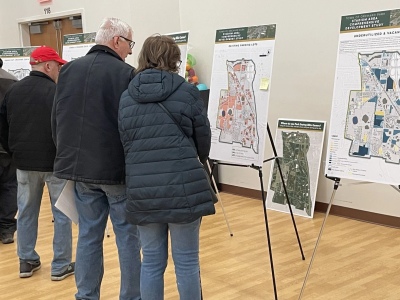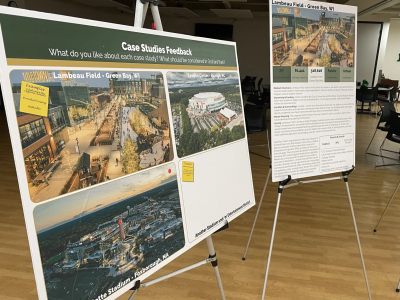
Restaurants, hotel would be nice but overdevelopment a concern for stadium neighbors
Residents were most on board with bringing retail, food and beer to the area surrounding the new Buffalo Bills stadium in Orchard Park. The other options included lodging and tourism, sports and recreation and multi-family housing.
Rob and Joanne Gannon live off Big Tree Road, essentially across the street from Highmark Stadium.
So, when it comes to bringing development to the area around the stadium, they’re in a somewhat precarious position.
They want to see the area thrive and for there to be more options to eat, recreate and stay.
But not too much to avoid it further congesting an area that is already difficult to navigate on game and event days at the stadium.
“We’d like to see something go up,” Joanne Gannon said.
“But we don’t want to see them overdevelop, because the traffic is already too much,” her husband added.

Residents look over information provided about the new stadium project and potential areas for development around the venue on Thursday night at the Orchard Park Community Activity Center.
The couple was among a steady flow of interested residents who showed up Thursday evening for an open house about stadium area development held at the Orchard Park Community Activity Center.
It is part of the Town of Orchard Park’s effort to craft a master plan for the area that officials say they hope will help find ways to play off the stadium and create year-round opportunities for businesses and the community.
The effort is referred to as the town’s Stadium Area Comprehensive Development Study, which is being funded using a $100,000 grant from the state.
Orchard Park officials were joined by representatives from the neighboring Town of Hamburg and Erie County at the open house. They have all joined forces to make sure development and rezoning efforts around the stadium are somewhat uniform.
Residents were able to chime in about what they wanted to see most in the area.

Residents look over information provided about the new stadium project and potential areas for development around the venue on Thursday night at the Orchard Park Community Activity Center.
LaBella Associates was hired as a consultant to lead the process of studying potential impacts of the new stadium on three areas in Orchard Park, including the northwest section of the town. It asked residents to mark what type of development they’d like to see and their visual preference for how they would like it to look aesthetically. It also asked which building styles they prefer. All the options presented have been identified in a study as viable for the area.
Residents were most on board with bringing retail, food and beer to the area. The other options included lodging and tourism, sports and recreation and multi-family housing.
“It would be nice to have more restaurants and stuff like that there,” said Rob Gannon, who lives on the Hamburg side of the border with Orchard Park. “There’s Danny’s and Big Tree Inn and that’s it.”
His wife said a hotel − possibly at the ECC South campus, which will be sold once the school leaves for a smaller footprint in the Southtowns − might make a good fit. She added that she would hate to see the campus become vacant and an eyesore.
Orchard Park recently adopted a resolution in October approving more business and development friendly zoning districts – the most critical one on or near Southwestern Boulevard neighboring the stadium. It will allow for hotels up to four floors to try to attract interested developers and help make the town more of a place to stay when events come to the stadium.
There were other desires expressed by residents, as well, most notably bringing sidewalks to what is a bustling Abbott Road on gamedays. But sidewalks would be an expensive proposition.
Erie County officials have said that if sidewalks were installed on both sides on Abbott Road to accommodate pedestrians, it would cost $500,000 per side, per mile, excluding any right-of-way costs.
“There needs to be a sidewalk or a shoulder,” said Marilyn Kanezetic, who lives close to the Abbott-Milestrip Road area. “They talk about making things more bikeable, but it’s not. They took that away when the county redid the road.”
She would also like to see green space around the team’s Abbott Road campus, which will include the stadium on one side and the team’s practice facility and corporate offices on the other.

LaBella provided three similar case studies for potential development in Orchard Park that has already occurred around other venues -
Lambeau Field in Green Bay, Gillette Stadium in New England and Lenevo Center in Raleigh.
“I live close by to the Bills Store at the stadium, and people come by all the time, and then they’re out front taking pictures – it’s an attraction,” Kanezetic said. “If they could just continue to take a little walk from there, maybe sit at a playground, buy a coffee, visit that little cemetery that is tucked away by the stadium, it becomes even more of an attraction. It’s a place maybe you can take the kids or grandkids a few times a year.”
LaBella provided three similar case studies for potential development in Orchard Park that has already occurred around other venues − Lambeau Field in Green Bay, Gillette Stadium in New England and Lenevo Center in Raleigh. Kanezetic liked the nature area around Gillette Stadium.
“That’s the kind of stuff I like,” she said. “Not all of these big hotels.”
Despite the efforts to promote development in the area, there are doubters that it will ever occur, with only so many events and games possible at an open-air stadium.
The current stadium has spawned almost no development over the past 50 years, and the new facility still will be an open-air venue that does not attract as many events as a dome could have.
“The question is how many people are going to build things around here for maybe eight Sundays a season,” Rob Gannon said.
“Who’s going to stay at a hotel in the area the other over 300 days a year,” Kanezetic said. “If the stadium was covered, maybe there would be more events there.”
The Bills have said they are trying to bring more than 100 events annually to the new stadium, using the playing field, as well as the state-of-the-art inside of the building.
“That would make it more feasible for people to start putting money into that area,” Rob Gannon said.
